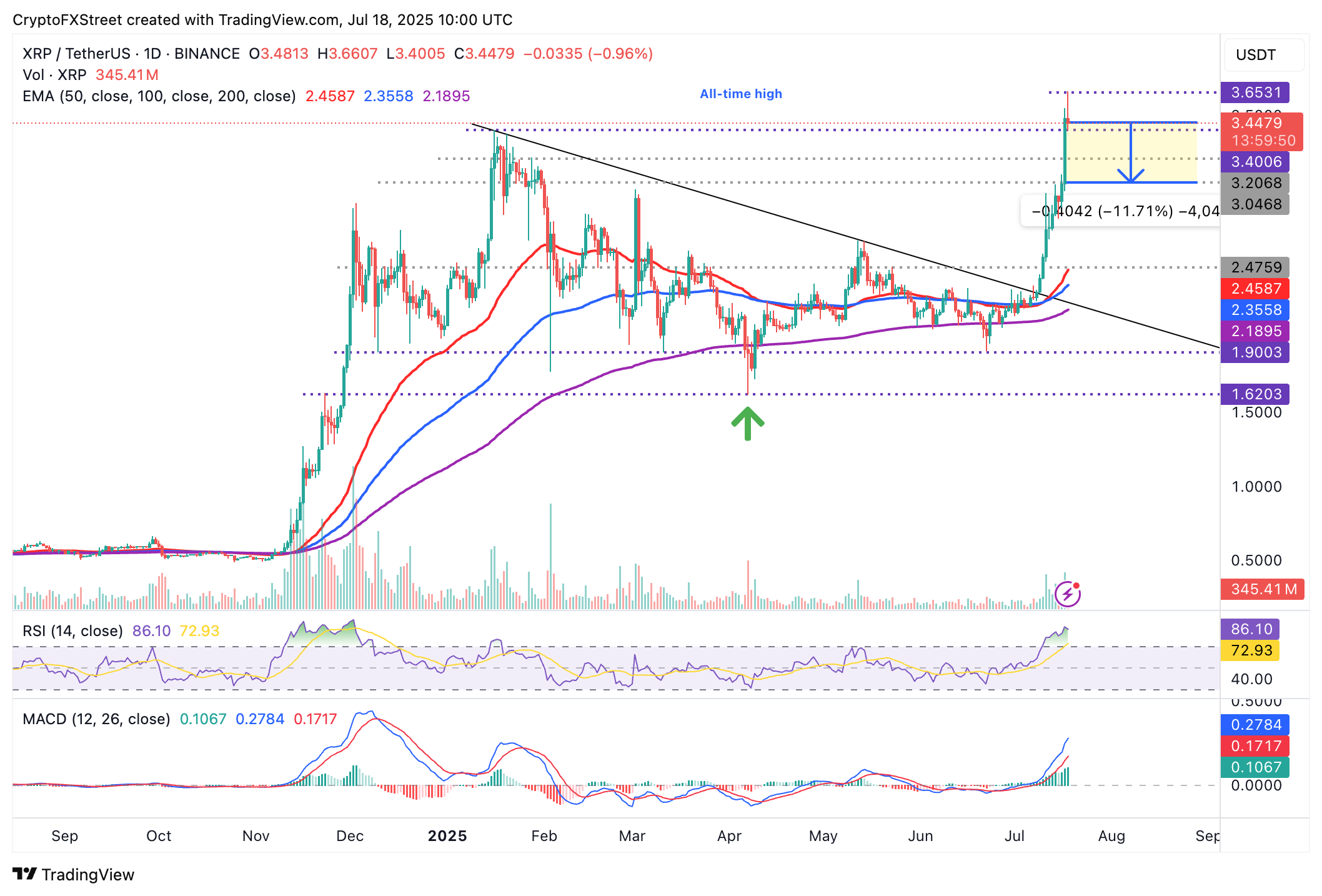- XRP price rallies on Friday, setting a new record high of $3.66 before retracing slightly.
- Ripple CEO Brad Garlinghouse called the passage of the GENIUS Act historic, cementing the US as a leader in innovative financial technology.
- Despite the price surge, XRP spot volume remains neutral, suggesting room for further upside.
Ripple (XRP) surged tremendously to a record high of $3.66 before pulling back slightly to $3.46 on Friday. Investors increased their exposure to the cross-border money remittance token, following the passage of three crypto bills in the United States (US) House of Representatives on Thursday.
The Guiding and Establishing National Innovation for US Stablecoins Act (GENIUS Act), the Digital Asset Market CLARITY Act (CLARITY Act) and the Anti-Central Bank Digital Currency Surveillance State Act (Anti-CBDC Act) all passed the House vote, potentially paving the way for clear cryptocurrency regulations in the US.
XRP offers signs of extending the rally after passage of key crypto bills
Ripple’s CEO, Brad Garlinghouse, has lauded the passage of the crypto bills, saying via a post on X that “the signing of the GENIUS Act cements the US’s future in being a leader in truly innovative financial technology – stablecoins.”
Apart from XRP, Ripple issues RLUSD, a regulatory-compliant stablecoin designed primarily for institutions. RLUSD is the 16th-largest stablecoin, boasting a market capitalization of $517 million.
The GENIUS Act is expected to establish a clear regulatory framework for stablecoins at both the federal and state government levels, thereby setting the stage for digital financial technology innovation in the US.
Ripple’s CTO, Stuart Alderoty, also hailed the passage of the GENIUS Act, which heads to US President Donald Trump’s desk for signing, saying that “at long last, there’s movement on workable, clear frameworks for crypto and stablecoins that will both foster innovation and protect consumers.”
Ripple has been working to establish its stablecoin infrastructure, aiming to be competitive with the Global SWIFT system. In June, Garlinghouse stated that the XRP Ledger (XRPL) could capture 14% of SWIFT’s liquidity, serving as a conduit between the traditional financial system and the digital asset economy.
Technical outlook: XRP could extend the price discovery phase
XRP price is currently trading at around $3.44, up slightly on the day at the time of writing. The token tagged a new record high of $3.66, underscoring increasing demand for both retail and institutional investors.
A Golden Cross pattern on the daily chart validated when the 50-day Exponential Moving Average (EMA) crossed above the 100-day EMA on July 11, cementing the bullish grip.
Additionally, a buy signal maintained by the Moving Average Convergence Divergence (MACD) indicator since June 28 has emboldened risk-on sentiment, calling on traders to increase their exposure.
A daily close above $3.50 could help ascertain the uptrend’s strength. If XRP breaks above the current all-time high of $3.66, a fresh price discovery phase could boost the token higher.

XRP/USDT daily chart
Despite the run-up to new record highs, volume in the spot market remains neutral, indicating that conditions are still favorable for XRP to extend its bullish leg to new levels, targeting $4.00 in the short term.
-1752849493280.png)
XRP Spot Volume Bubble Map: Source: CryptoQuant
Meanwhile, the extremely overbought Relative Strength Index (RSI) at 86 signals the possibility of a trend correction, especially if profit-taking activities increase, overshadowing demand. The previous record high at $3.40 serves as tentative support, but if broken, traders will look for support at $3.00, which was tested in early March as resistance, and $2.80, which was tested as support on Tuesday.
SEC vs Ripple lawsuit FAQs
It depends on the transaction, according to a court ruling released on July 14, 2023:
For institutional investors or over-the-counter sales, XRP is a security.
For retail investors who bought the token via programmatic sales on exchanges, on-demand liquidity services and other platforms, XRP is not a security.
The United States Securities & Exchange Commission (SEC) accused Ripple and its executives of raising more than $1.3 billion through an unregistered asset offering of the XRP token.
While the judge ruled that programmatic sales aren’t considered securities, sales of XRP tokens to institutional investors are indeed investment contracts. In this last case, Ripple did breach the US securities law and had to pay a $125 million civil fine.
The ruling offers a partial win for both Ripple and the SEC, depending on what one looks at.
Ripple gets a big win over the fact that programmatic sales aren’t considered securities, and this could bode well for the broader crypto sector as most of the assets eyed by the SEC’s crackdown are handled by decentralized entities that sold their tokens mostly to retail investors via exchange platforms, experts say.
Still, the ruling doesn’t help much to answer the key question of what makes a digital asset a security, so it isn’t clear yet if this lawsuit will set precedent for other open cases that affect dozens of digital assets. Topics such as which is the right degree of decentralization to avoid the “security” label or where to draw the line between institutional and programmatic sales persist.
The SEC has stepped up its enforcement actions toward the blockchain and digital assets industry, filing charges against platforms such as Coinbase or Binance for allegedly violating the US Securities law. The SEC claims that the majority of crypto assets are securities and thus subject to strict regulation.
While defendants can use parts of Ripple’s ruling in their favor, the SEC can also find reasons in it to keep its current strategy of regulation by enforcement.





